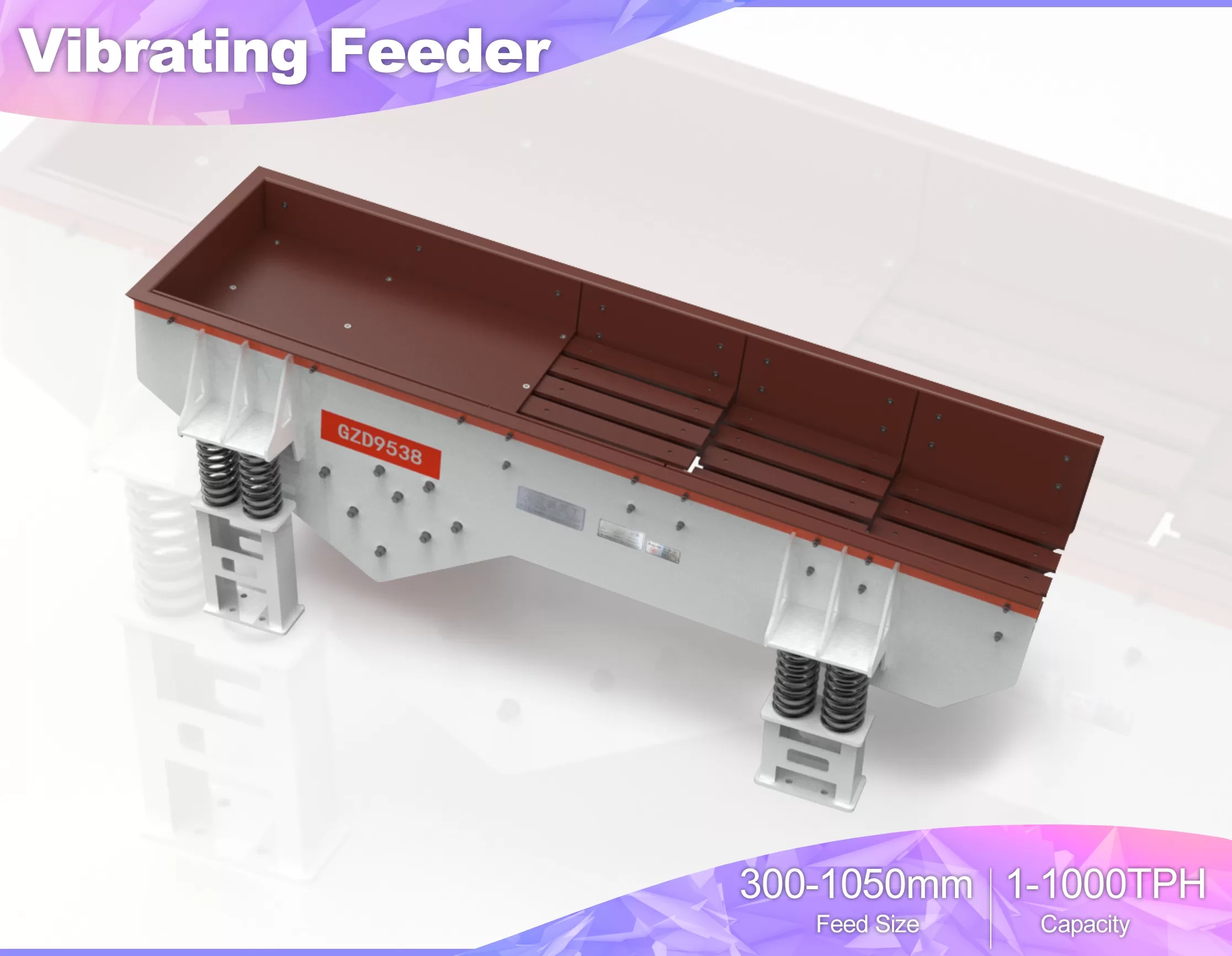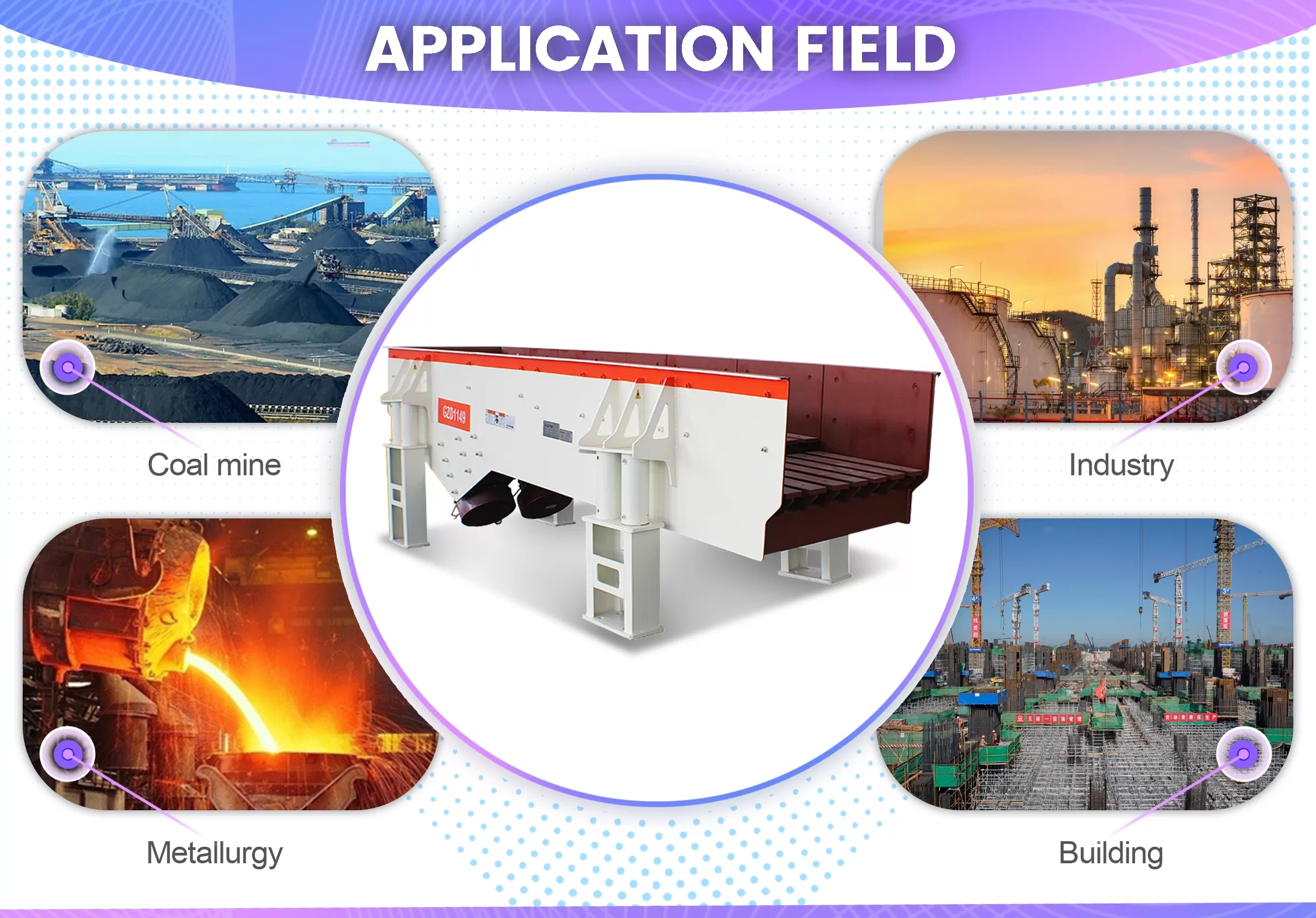Search the whole station Crushing Equipment
The vibrating feeder (vibratory feeder) is suitable for bulk and granular materials such as limestone, calcite, dolomite, barite, talc, gypsum. And also quartz stone, river pebble, granite, basalt, construction waste, iron ore, coal, slag, etc.
The vibrating feeder can evenly feed materials for the crushing equipment in the sand production line, and screen materials roughly. And also it can serve materials for belt conveyors, bucket elevator, screening equipment, crushing equipment and grinding machines.
A Vibrating Feeder, sometimes called a vibratory feeder, is industrial equipment to convey bulk materials over a short distance at a controlling rate. Think of it as a short, sturdy vibration conveyor with a motor that makes it shake. This controlled shaking action moves the material forward. This machine is a critical part of any feeder system, taking a large pile of material from a vibrating hopper and turning it into a consistent, predictable stream that other machines, like crushers, can handle efficiently.

Mining vibrating feeder has a very wide range of use. This equipment applys in mining, metallurgy, coal, building materials, chemical industry, electric power and other industries. The following is the specific scope of use:

The working principle of the vibrating feeder is mainly to use the eccentric block in the vibrator to rotate to produce centrifugal force, so that the movable parts of the screen compartment and vibrator make a forced and continuous circular or nearly circular motion. This movement is transmitted to the conveying trough connected to the vibrating motor, so that the material is subjected to vibration force in the trough, thus generating sliding and dislodging, and realizing the uniform and continuous conveying of materials.
The machine consists of a trough or pan, which holds the material, mounted on flexible springs. A vibrator unit, which is either an electric motor with eccentric weights or an electromagnetic feeder drive, is attached to the pan. When you turn it on, it creates powerful, rapid vibrations. This motion moves the pan in a quick, repeated forward-and-up, backward-and-down cycle. Each tiny “throw” lifts the material and moves it forward, creating a smooth, continuous flow.
In addition, the mining vibrating feeder can also be adjusted by adjusting the phase and weight of the eccentric block to change the size and direction of the excitation force, so as to adapt to the changes in different materials and process requirements. This kind of adjustment is flexible and convenient, and can realize precise feeding control.
Using a vibration feeder provides several major benefits for your production line. The most important advantage is flow control. You can precisely adjust the feed rate, ensuring downstream equipment runs at peak efficiency and protecting expensive machines from damage. They are also very reliable with low maintenance needs because they have few moving parts. A key advantage of the vibrating grizzly feeder is its ability to act as a pre-screener. It has parallel bars that allow smaller particles to fall through, removing fines before they even reach the crusher, which boosts the efficiency of the entire circuit.

A Vibrating Feeder is built to handle a very wide range of bulk materials, especially in tough environments. They are designed to move heavy, abrasive, and large-sized materials with ease. As a dedicated aggregate feeder or ore feeder, it handles:
The robust construction of this vibratory equipment ensures it can withstand the constant impact and wear from these tough materials.
A vibratory feeder has a simple and strong structure with three main parts. First is the feeder pan or trough. This is the heavy-duty steel body that holds and conveys the material. It is often lined with replaceable wear plates. Second is the vibrator. This is the “engine” of the feeder. It can be a mechanical unit with a motor and eccentric weights or a quieter electromagnetic drive. Third is the suspension system. This usually consists of heavy-duty coil springs that allow the pan to vibrate freely while supporting its weight and isolating the vibratory force from the support structure.
There are two main types of vibrating feeders, categorized by their drive mechanism. The choice depends on your application’s needs for power and control.
Choosing the right feeder machine is critical for your plant’s performance. You must consider several key factors to make the correct decision.
The price of a vibrating feeder can range from a few thousand dollars to over $50,000 for a large, heavy-duty model. The cost depends on size, capacity, and drive type. However, beware of assuming all feeders are created equal. Cheaper models often have undersized vibrators and weak frames, leading to inconsistent feed rates and frequent breakdowns. It’s better to consider the total cost of ownership. Investing in a robust machine from a reputable feeder manufacturer like ZONEDING might cost more upfront but will save you money from lower energy use, less downtime, and a much longer service life.
| Model | Max.Feeding Size(mm) | Processing Capacity(t/h) | MotorPower(kw) | Obliquityof materialtrough(°) | Troughsize(mm) | Dimensions(mm) |
| GZD-650×2300 | 300 | 80-100 | 1.2×2 | 10-20 | 650×2300 | 2300×1360×780 |
| GZD-750×2500 | 350 | 100-130 | 1.5×2 | 10-20 | 750×2500 | 2500×1460×780 |
| GZD-850×3000 | 400 | 120-150 | 3×2 | 10-20 | 850×3000 | 3110×1800×1600 |
| GZD-1000×3600 | 500 | 150-200 | 3.7×2 | 10-20 | 1000×3600 | 3850×1950×1630 |
| GZD-1100×3600 | 580 | 240-300 | 3.7×2 | 10-20 | 1100×3600 | 3600×2050×1660 |
| GZD-1300×3600 | 650 | 450-600 | 7.5×2 | 10-20 | 1300×3600 | 3900×2350×1750 |
| GZD-1500×3600 | 1050 | 450-1000 | 7.5×2 | 10-20 | 1500×3600 | 3900×2000×1750 |
| GZD-2000×3600 | 1200 | 550-1000 | 10×2 | 10-20 | 2000×3600 | 3600×2000×1750 |
| GZD-2500×5000 | 1500 | 650-1500 | 18×2 | 10-20 | 2500×5000 | 5000×2500×1800 |
| ZSW-380×95 | 500 | 100-180 | 11 | 0-10 | 3800×960 | 3920×1640×1320 |
| ZSW-490×110 | 630 | 150-400 | 15 | 0-10 | 4900×1100 | 4980×1830×1320 |
| ZSW-490×130 | 750 | 400-700 | 22 | 0-10 | 4900×1300 | 4980×2580×2083 |
| ZSW-600×130 | 750 | 400-700 | 22 | 0-10 | 6000×1300 | 6082×2580×2083 |
| ZSW-600×150 | 800 | 500-900 | 30 | 0-10 | 6000×1300 | 6086×2662×1912 |
| ZSW-600×180 | 900 | 700-1300 | 45 | 0-10 | 6000×1500 | 6310×3262×2230 |
| ZSW-600×200 | 1200 | 800-1500 | 55 | 0-10 | 6000×2000 | 6310×3462×2230 |
Several factors impact how well your material feeder works. The most critical is the material’s characteristics, such as moisture and stickiness. The feeder’s setup is also key. A crucial technical detail is the vibrator’s stroke angle—the direction of the vibration. A steeper stroke angle creates a more aggressive action, which is better for heavy or sticky materials. A shallower angle is gentler, suitable for fragile materials. Experimenting to find the optimal angle for your material is important for top performance.
Q1. Who are we?
A1: Zoneding Machine is manufacture of mining machine which is located in Henan province of China. We have been professional on grinding mill, stone crushers, sand making machines, production line for ore beneficiation, sand and aggregate industries since 2004.
Q2. What is our main crusher products?
A2: Jaw Crusher/Cone Crusher/Vibrating Screen/Sand Making Machine/Mobile Stone Crusher Plant/Vibrating Feeder/Fine Sand Recovery Machine/Screw Sand Washing Machine/Impact Crusher/Vertical Shaft Impact Crusher/Hammer Crusher/Belt Conveyor/Stone Crushing Plant.
Q3. What about the price ?
A3: We are able to give you competitive price than market one cuz we are factory, and we have a policy that ” for saving time and absolutely honest” business attitude,we quote as low as possible for any customer, and discount can be given according to quantity
Q4. What services can we provide?
A4: Accepted Delivery Terms: FOB, CFR, CIF;
Accepted Payment Currency: USD,EUR, CNY;
Accepted Payment Type: T/T,L/C;
Language Spoken: English,Chinese,Spanish,Arabic,French,Russian
Q5: When will the delivery be?
A5: For inventory goods, we can ship them within 3-5 days. For customized equipment and other devices, we will specify according to clients’ needs as we quote.
Jaw Crushers Applicable Material:Quartz, granite, basalt, limestone, river stone, marble, shale, iron ore, copper ore, gold ore etc. A Jaw crusher is mainly used for medium-sized crushing of various ores and…
Cone crusher is usually used as secondary or tertiary crushing stage. It is characterized by robust structure, excellent productivity and simple operation. Cone crusher is ideal for crushing different stone and ro…
Sand making machine is suitable for soft or medium hard and very hard ore materials with hardness not higher than 320 Pa. Also. It has the characteristics of stable and reliable work, easy maintenance, and a high sand production rate. The…
Impact crusher excel in primary crushing of rock. Stationary and mobile plants are available. Replacement of wearing parts is simple due to the hydraulic folding of the housing components. A variety of models are available | Get the fre…
Sand washing machine is an important equipment for artificial sand and natural sand washing operation. It can wash away the trace stone powder and impurities in sand and gravel to improve the quality of sand. A&…
Vibrating Screen characterizes simple structure, high efficiency, reliable use and convenient installation, and can perform multi-special segmentation screening of loose materials. It is main equipment to separate soild materials, it …
Roller crusher is also known as roll crusher, which relies on the high-speed rotation of roll wheel to crush materials. The commonly used roll crusher types include double roller crusher, toothed roller crusher, four roller crusher, etc. …
Fine crusher is also called tertiary crusher, which adopts the principle of “stone hit stone” to crush materials. It upgrades the traditional three crushing stages to the two crushing stages. A Fine Crusher&n…
Compound crusher is the newly developed equipment by combining sand making machine and the crushing principle of impact crusher. A compound crusher, also called vertical compound sand maker, is a double-rotor prim…
Hammer crusher is The high-speed rotating hammer collides with the material to crush the material. It can be crushed in dry and wet forms. A Hammer Crusher, also known as a Hammer Mill Crusher, is a ma…
loading…
已经是到最后一篇内容了!
We use cookies to ensure that we give you the best experience on our website. If you continue to use this site we will assume that you are happy with it.
Privacy Policy